Inspiration and Vision: Early Beginnings
What originally brought you to Landscape Photography? The answer I hear from most people when faced with this question is that “I had a desire to share with others my experience of visiting beautiful places while traveling, hiking and backpacking. Typically these experiences are charged with deep emotions that have a profound and lasting effect on the individual. But the resulting images often fall way short of expressing the emotions and feelings surrounding the sense of place. Instead the images are largely documentary and also are not good even from a technical perspective. But make no mistake, the photographer felt a great sense of inspiration at the moment of capture.
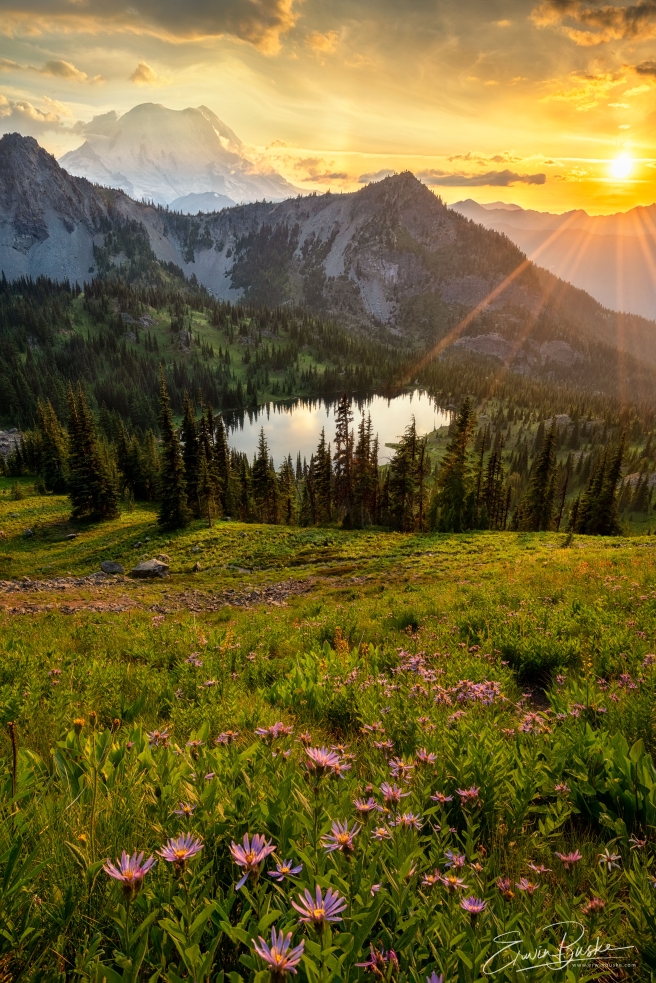
“I may pass this way again”
Often we will return to a place as our photographic skills evolve to rekindle and capture the emotions we originally felt as we were just starting out in photography. This is such a place and last week I made this return journey.
Inspiration and Vision: Progression
The desire to better capture the emotions and feelings surrounding a sense of place helps motivate the photographer to learn. The photographer begins the process of learning the technical aspects of photography: aperture, shutter speed, ISO, focus, angle of view, image development, etc. This is learning photography as a craft. The photographer also begins learning the basics of composition: lines, shapes, patterns, subject placement, light, creative processing, etc. This begins the process of learning the art of photography. But as the photographer embarks upon this path of learning, he or she may feel that some of the energy and enthusiasm that originally brought them to landscape photography is missing. It is easy to get caught up in the technical and learned compositional approaches to photographay. The process becomes almost mechanical and may not be in touch with a vital link to the world of feeling and emotion and who one is as a person. It is at this point that the landscape photographer begins looking for new sources of inspiration.
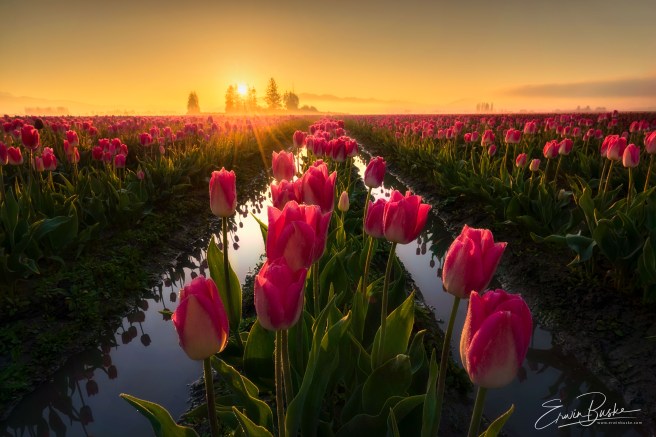
Morning Dew
I felt a tremendous sense of emotion that touched the depths of my soul as this scene slowly evolved as the sun rose over the tulips fields shrouded in mist and morning dew. All of the techniques involved in capturing this image, including the near far compositional approach emphasizing the dew, reflections and sun’s rays— were directed at expressing my emotions and feelings of this place at this most memorable time. I did not employ technique and compositional artistry for its own sake.
Sources of Inspiration
I will now discuss each of the following sources of inspiration. Some of these may seem surprising to photographers and contrary to the advice they may have received from other influencers, but bear with me and I will establish the value of each of these sources of inspiration in helping guide one’s photographic journey.
- Visiting Iconic Places
- Published Images
- Other Photographers
- Going off the Beaten Path
- Alternative Perspectives
- Going to New Places
- Beauty in Familiar and Ordinary Places
- Taking a break from Photography
- Keeping a Journal
- Internal Sources of Inspiration
(1) Visiting Iconic Places
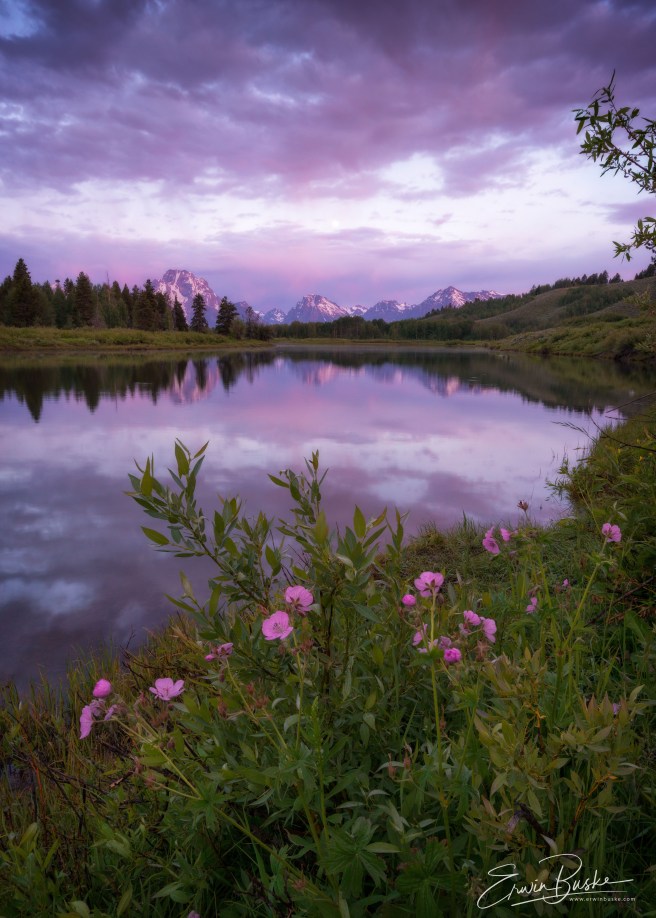
Wild Geranium Tetons Sunrise
This image was taken at the iconic site of Oxbow Bend in Grand Tetons National Park.
It can be challenging to create a unique composition in an iconic place, but if one follows their instincts and intuition for what is interesting in the scene and perhaps also receives a blessing from mother nature of unique weather and flora, it is not only possible but also probable. Iconic places are iconic for a reason. They have the power to instill strong emotional reactions and even have symbolic value in our collective psyche that can be tapped into and shared instilling similar emotions in others. Every year individuals and families make pilgrimages to such iconic sites as Oxbow Bend, Yellowstone Falls, Crater Lake and others for precisely this reason. Never underestimate to power of visiting an iconic site.

Eye of the Crater: Crater Lake National Park
(2) Published Images
In our modern internet world images are published in a number of ways. Some are published in traditional sources such as printed magazines such as Outdoor Photographer or presented in physical galleries, but increasingly images are published in online magazines such as Landscape Photography Magazine. Perhaps the most accessible source of images is Social Media which includes Facebook, Flickr, Instagram and 500px. There are also websites where we can find the work of individual photographers and their blogs. All of these sources of published images can serve as great places for photographers to go for inspiration. It is important, however, when viewing these images to prioritize ones time, looking at the images that are not only good but also resonate with ones own artistic sensibilities. It is also important to engage in what Miles Morgan calls “Active Viewing”. To quote Miles:
“By “actively view” I mean that you aren’t just looking at pretty pictures. You’re trying to figure out WHY you like the image. What makes the image work vs. the other images you find less appealing? How can you incorporate those techniques yourself? What images DON’T interest you? Why not? How can you avoid the pitfalls that made the photograph less intriguing?”
In viewing published images we are not trying to replicate what others have done. Although it is possible that a published image may provide inspiration for reinterpretation of what others have done, the process of active viewing is better viewed as a process that will help us grow and better equip us to fulfill our own vision of an altogether different place and time.

Epiphany
This image of the Enchantments was recently published as the final frame in the July issue of Landscape Photography Magazine. For more on my Enchantments adventures see Visiting and Photographing the Enchantments.
(3) Other Photographers
None of us are an island onto our self and we are all indebted to not only those who came before us but also to landscape photographers currently operating in the field. One can find an immense source of inspiration through following the life and work of photographers who we admire. I recommend picking only about three or four to follow in depth. Questions to consider include:
- What makes the photographer tick?
- What brought you to photography?
- Who inspires you?
- What is the photographer’s signature style, and has it changed over the years?
- What are the stories behind the photographs
To truly appreciate the work of the photographer we need to get to know who he or she is as a person, which will of course take time and effort. If the photographer is featured in a podcast, listen to it. Read their blogs and social media posts. Watch their tutorials. Reach out to the photographer, let them know you are inspired by their work, and cultivate some one on one communication, perhaps even friendship. If they offer workshops, attend their workshop.
As I have progressed as a photographer over the years their are several photographers whose work I admire that I have reached out to. These include Art Wolfe (I attended a workshop early on and various presentations and have read many of his books), Candace Dyar (attended a workshop and communicate with her frequently), Nick Page (regularly listen to his podcast and watch his tutorials) and Michael Gordon (recently participated in a one on one workshop and tour in the Death Valley).
Along somewhat similar lines, many landscape photographers find inspiration and even a sense of belonging in joining other photographers for social photography in the field. This can be done formally through clubs or more informally through meet ups and circles of friends deciding to get together. Companionship and collaboration with like-minded people can also facilitate additional learning as one sees how others approach the art and craft of photography. My only caution here is that although we are social by nature and need this kind of interaction, it is also true that to fully blossom as an artist one needs to ultimately cultivate more inner sources of inspiration. I will discuss this more later in the article in the tenth source of inspiration, inner sources.
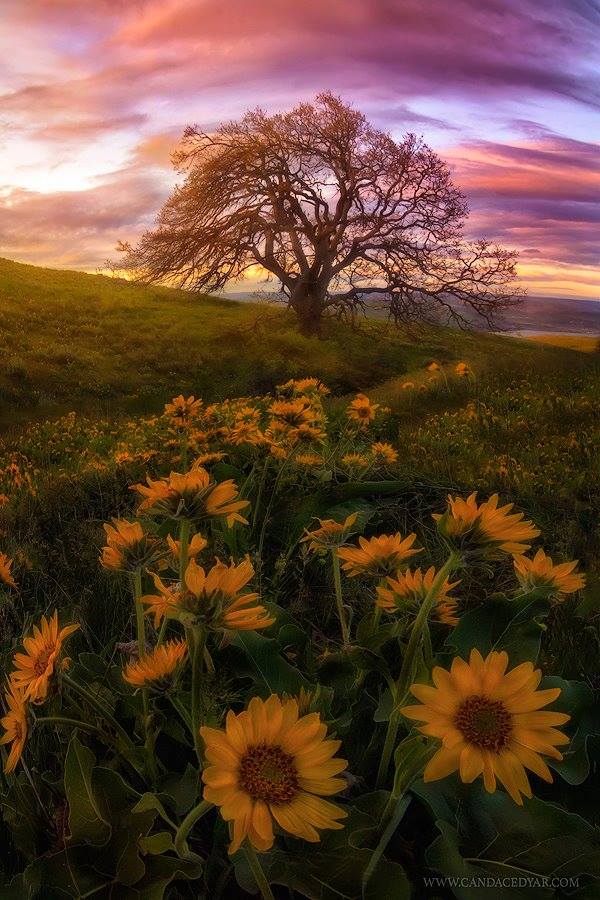
Here Comes the Sun by Candace Dyar
I have been following the work of Candace for about five years now and just love her painterly approach and color harmony in her images.
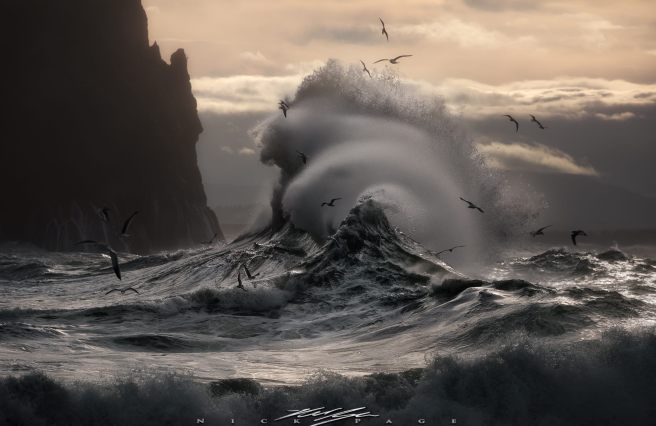
Unrest: Nick Page
It has been amazing to watch Nick progress as a photographer over the past few years We are witnessing the appearance of a new Northwest Icon (and entertainer to boot!)
(4) Going off the Beaten Path
Going off the beaten path or taking the road less traveled can provide fresh perspectives and inspiration through the process of discovery. This also increases the likelihood that your vision will be unique allowing you to take better ownership of your vision. Because these spots are also far less photographed, the influence of other photographers on your vision will be less. Some of the absolute best times in my life as a photographer occurred when I felt I was experiencing nature in a way that few if any have witnessed before. Of course part of this is how we bring our own thoughts, emotions and feelings to the landscape, but the other part of this is the landscape itself speaking to us, sharing with us the unique spirit of the place and time that few get to see. Going off the beaten path can also take the form of a multi-day backpacking trip into the wilderness, the ultimate source of inspiration. For more on this see my blog post Multi-Day Backpacking and Photography
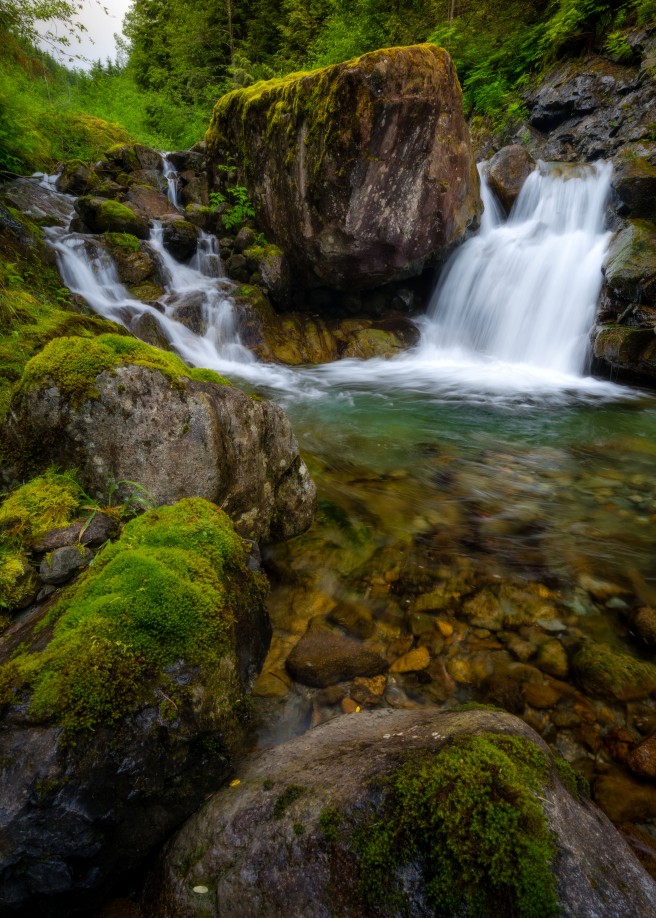
Boulder Falls
Off trail somewhere in the Snoqualmie National Forest
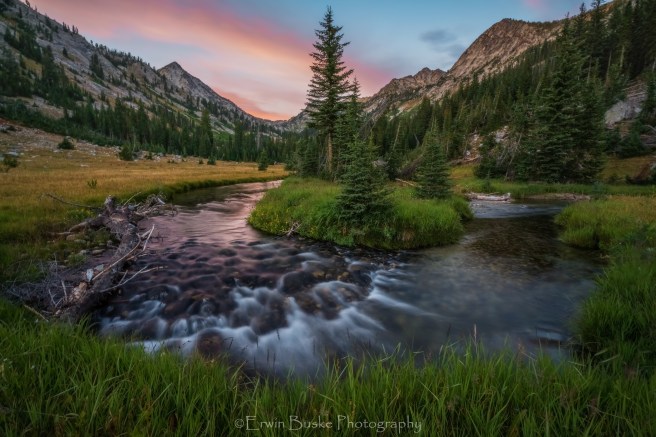
Rivers Bend: Eagle Cap Wilderness Area
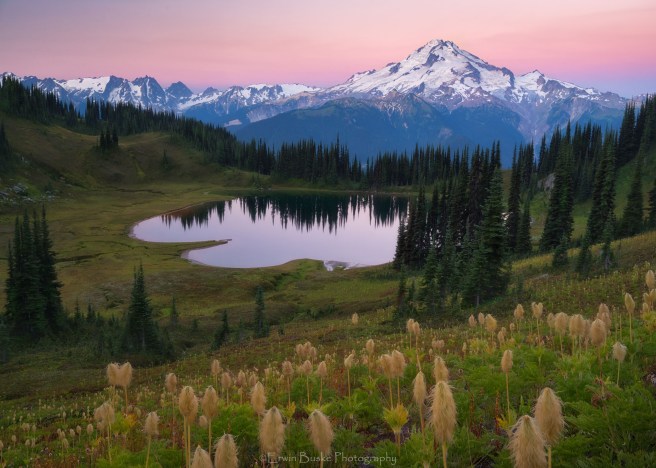
Image Lake at Sunrise
I reached this beautiful lake in the Glacier Peak wilderness area, and 18 miles in, as part of a multi-day backpacking trip. For more on this adventure see Visiting and Photographing the Glacier Peak Wilderness Area: Spider Gap – Buck Creek Pass Loop.
(5) Alternative Perspectives
Most landscape photographers at the current time demonstrate a preference for wide angle color photography that seems ideal for the Grand Landscape, balancing foreground, mid-ground and background elements. The over reliance, however, on this formulistic approach can often seem contrived to others and also can be self limiting. Expressing what we feel about a place and time often calls for a different perspective. One can usually find new sources of inspiration through experimenting with alternative perspectives including the use of Telephoto, Macros, Abstracts, and Black and White. For more on alternative perspectives see these two blog posts: One: Going Wide, Going Narrow, Creating Layers of Beauty and Two: Forests in the Mists: Windows into the Active Imagination.
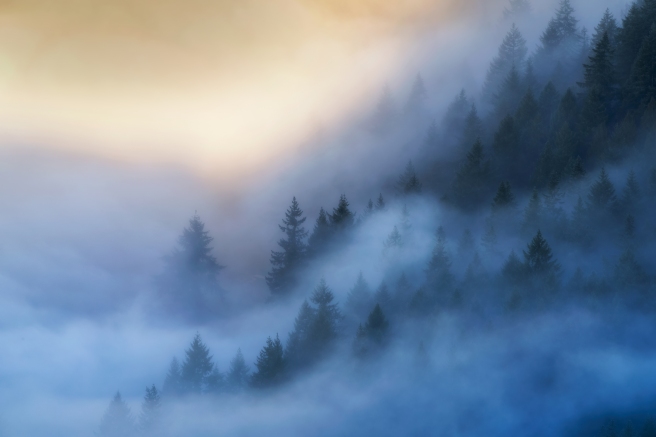
Spirit Angels in the Forest: 400MM Telephoto Perspective
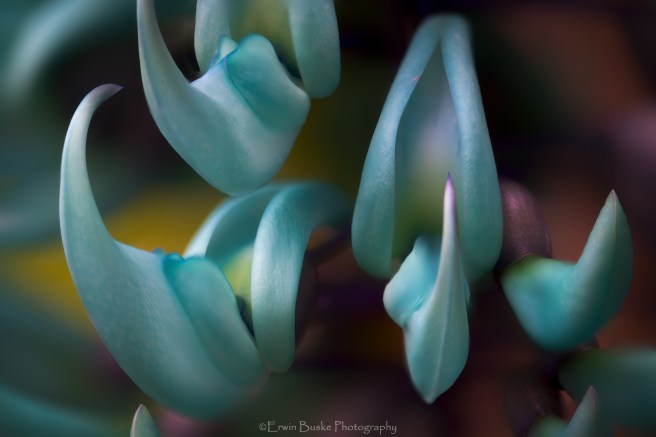
Jade Vines: Macro
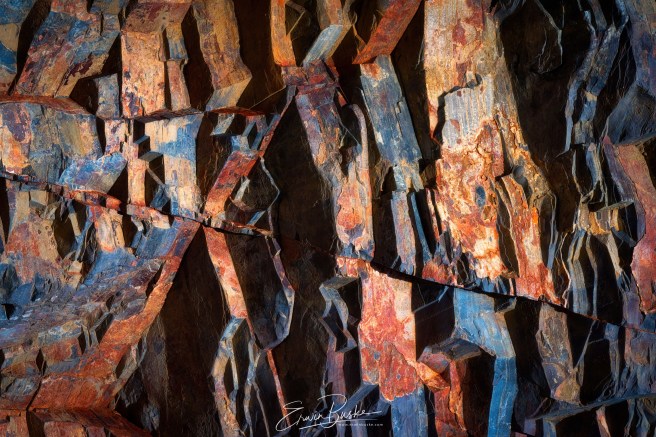
Rock Tapestry: Abstract
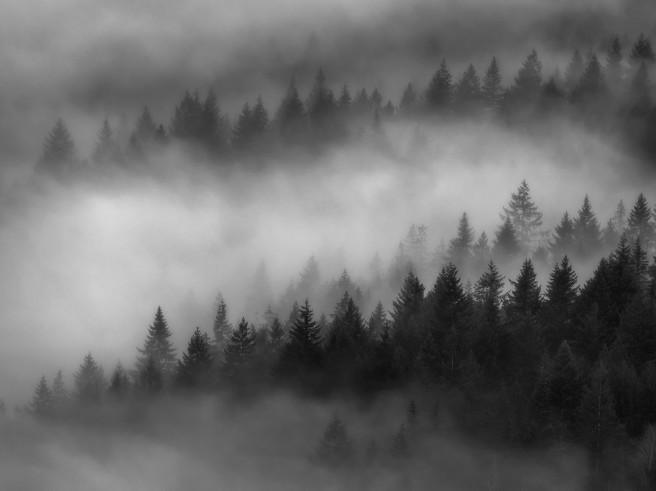
Mystery: Black and White and 500mm Telephoto
(6) Going to New Places
Visiting a new (to you) place can be a powerful source of inspiration building excitement, passion, and enthusiasm. One often experiences completely different landscapes than one is accustomed to see and this helps separate us from our habitual way of viewing and experiencing our small world leaving us open to fresh visions and possibilities. I try to plan one or two trips a year to places that are markedly different than my own native Pacific Northwest. This year I visited Kauai and Death Valley.

One with the Ocean
When reviewing my images from a a trip in February to Kauai, this one surprised me the most. I did not at all see my shadow and silhouette in the spray of the wave at the moment of capture. But there I was, walking into the ocean of Kauai’s Shipwreck Beach, tripod in hand, one with the Ocean!
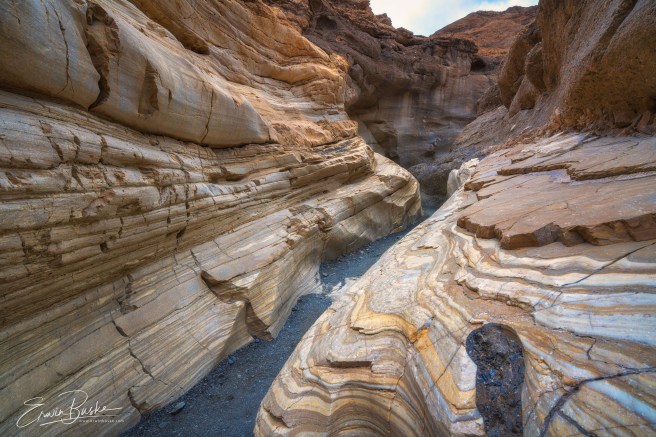
Death Valley: Mosaic Canyon Wooden Grains
(7) Beauty in Familiar and Ordinary Places
One can feel a tremendous sense of accomplishment and inspiration through finding beauty in familiar and ordinary places. Often this beauty is not obvious and may be hidden. No where have I gained more traction in developing my skill set than in presenting an ordinary place in the best light. This is also the ultimate confirmation to others that you have arrived as a photographer through your ability to make even the ordinary look good. Often this beauty was recognizable to us all along, but conveying this beauty that is often very personal to others remains a huge challenge. But if one can communicate a sense of your “Feeling” of a place at these somewhat ordinary and mundane locations, think how much easier it will be to do this at iconic sites and other places where the beauty is so obvious to everyone!

Bleeding Hearts of the Forest
I make this small journey through a quite ordinary forest close to home almost daily but one day last spring this scene jumped out at me, and I rushed home to fetch my serious camera and tripod to create this image!
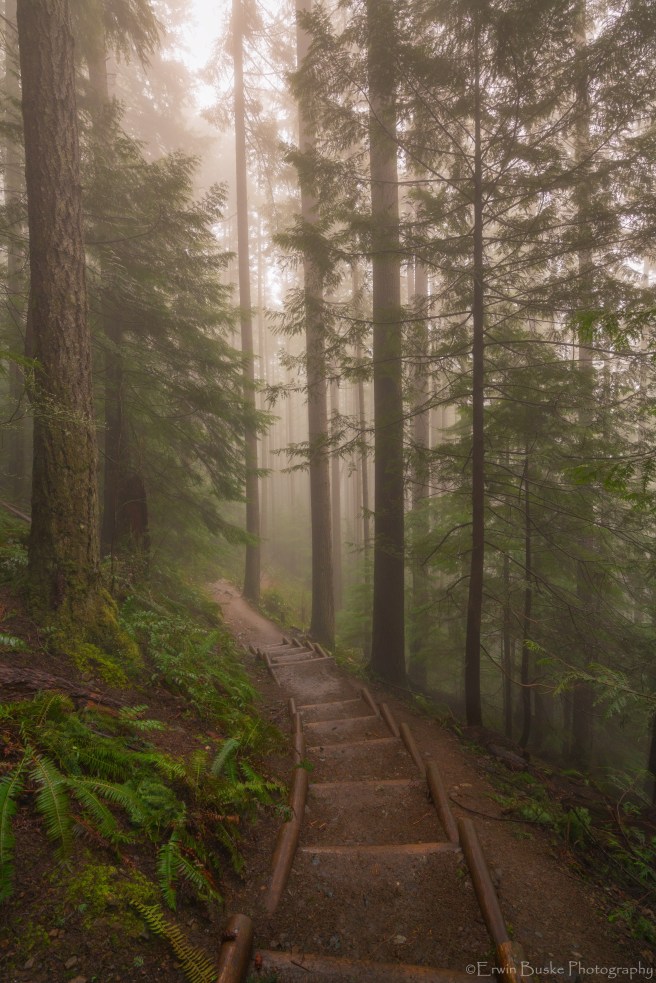
Foggy Trail
Most people zip up or down this section of trail through second growth forest on their way to Mt. Si- a first flank peak close to the Seattle area. But on this foggy day I immediately recognized the potential for impact and beauty on this ordinary stretch of trail. This trail is so much more than just a conditioning hike (how it is typically regarded). It is a sanctuary of exquisite beauty just waiting to be discovered.
(8) Taking a break from Photography
Many of my colleagues have taken a break from social media. Social media, although very useful for gaining exposure, can also consume too much of our time and influence our creative choices if we chase after popularity. But just as social media can stand in the way of creative fulfillment, so can photography itself. Often times we need a break of sorts, a vacation free from photography. When we return from this vacation, we often will have a much clearer view of where we need to go from a creative perspective. Experts have known for a long time that excessive and obsessive work toward a goal (the workaholic syndrome) can actually hinder creativity due to loss of perspective. Landscape Photography is no exception to this rule.
Often time during a break from photography one can find new sources of inspiration through such activities as reading books, long walks in the woods without a camera, visiting art galleries, and reconnecting with old friends. I regularly listen to audio books while taking long walks in the forest. These audio books include biographies on Emerson and John Muir, Emerson’s Essays, Julia Cameron’s The Artist’s Way, and other titles.
(9) Keeping a Journal
Julia Cameron in her classic book, The Artist’s Way, established two key activities that help the Artist find new sources of creative inspirations. Both of these activities help connect the artist to his/her authentic self which is the source of all creativity. The first activity is keeping a daily journal. Spend 10 or 15 minutes a day writing in your journal what ever comes up-thoughts, emotions, feelings, impressions. This journal is not specifically about photography and is more open ended than that. The purpose of journal writing is getting one more in touch with ones inner self and the subconscious, to fully awaken to who one is as a person. The next activity is establishing a date with oneself at least once a week. Landscape photographers need time alone in nature to better connect with who they are as a person uninfluenced by the thoughts or actions of others. These artist dates will also provide the basis for journal entries that no one reads other than our self. For more on the authentic self, see my blog post Finding your Photographic Vision and the Search for the Authentic Self.
(10) Internal Sources of Inspiration
“Your vision will become clear only when you look into your heart. Who looks outside, dreams. Who looks inside, awakens..” –Carl Jung
“Be yourself; no base imitator of another, but your best self. There is something which you can do better than another. Listen to the inward voice and bravely obey that. Do the things at which you are great, not what you were never made for.” –Ralph Waldo Emerson, Self Reliance.
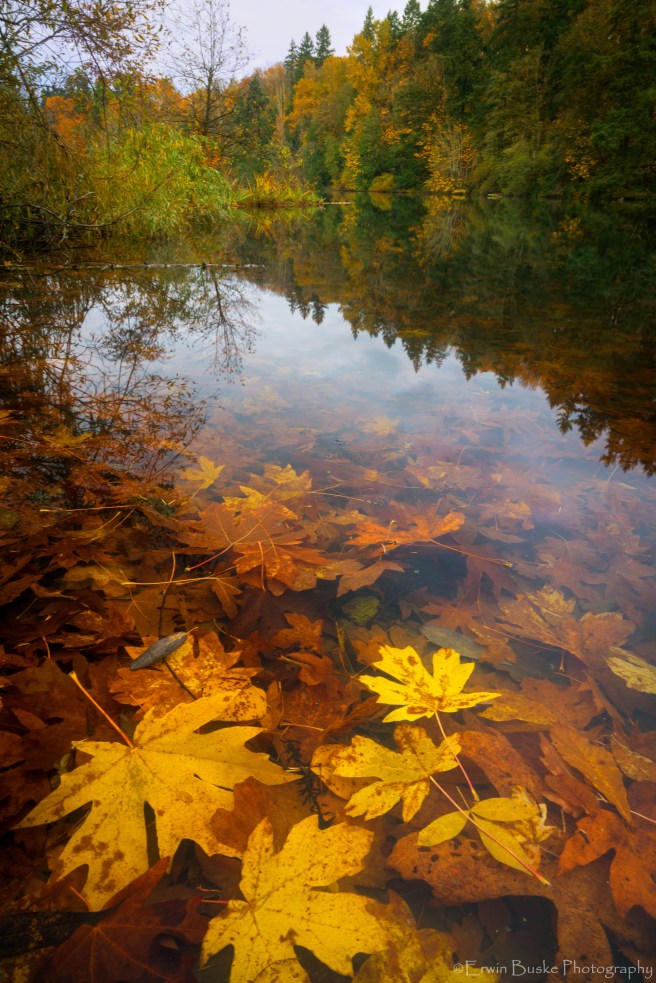
Submerged Leaves Under Water
Tapping into Internal sources of inspiration should be the guiding light for all of the the previously mentioned sources of inspiration. What we are talking about here is getting in touch with the right side of the brain, the wellspring of creativity, emotions, imagination and the subconscious. We leave behind all societal expectations about where we should go with our photography and art. This is a journey that marks the return to nature and our true nature and authentic self. We create images as expressions of this authentic self. This marks the integration of the internal and external landscape, with a soulful nature guiding us symbolically to a spiritual world. This is a world of paradox. Even as we descend into the soulful grasp of earthly nature, we are lifted up into a more lofty spiritual realm. We need both. Images have emotional impact, and images tell our personal story. Images now move beyond documentation as we share our experience of a time and place. The images themselves help us and the viewer transcend this earthly world, and evoke a mood that points to matters that may seem beyond comprehension, the world of pure idea and spirit. This is nature and landscape photography as art.
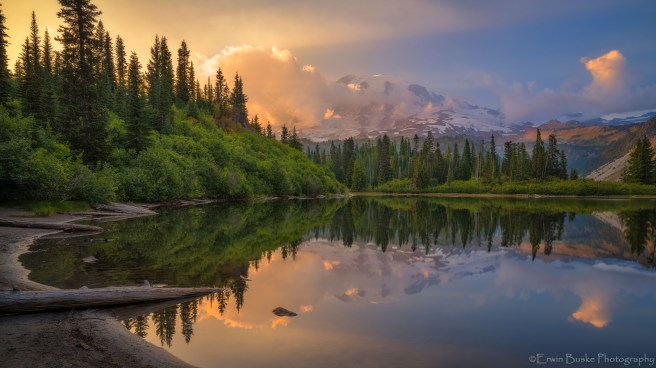
Where the Angels Roam: Mt. Rainier National Park
Conclusion
When we are in a creative rut, many of us need to look to new sources of inspiration. All of these sources of inspiration discussed in this post can help us in our journey to live a more authentic life when the progression is from external to internal sources of inspiration. Living a more authentic life will ultimately also provide the needed inspiration for reaching our creative potential with landscape photography.
“Man is never so authentically himself than when at play” –Friedrich Schiller
What Schiller meant by play (also often referred to as a state of flow, Mihaly Csikszentmihalyi) is when one follows with passion and joy his or her calling, For me this is Nature and Landscape Photography and I suspect for many who are reading this it is for you also.
Erwin Buske Photography (c) 2018
Thanks for reading this blog post. I greatly appreciate this and would love to hear from you. Please leave a comment with your thoughts on this posts. If you would like to receive additional posts like this please also follow this blog either through word press or a request for email notifications. Thanks! Erwin

